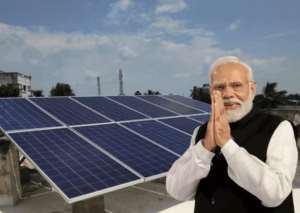आज के समय में, दुनिया एक गंभीर ऊर्जा संकट का सामना कर रही है। पारंपरिक ऊर्जा स्रोत जैसे कोयला और पेट्रोलियम सीमित हैं और इनके उपयोग से पर्यावरण को भी भारी नुकसान होता है। ऐसे में, नवीकरणीय ऊर्जा स्रोत जैसे सोलर ऊर्जा, पवन ऊर्जा और जल विद्युत, ऊर्जा की जरूरतों को पूरा करने का एक स्थायी और स्वच्छ विकल्प प्रदान करते हैं। सोलर ऊर्जा, जो सूर्य की रोशनी से प्राप्त होती है, विशेष रूप से महत्वपूर्ण है क्योंकि यह प्रचुर मात्रा में उपलब्ध है और इसका कोई हानिकारक उत्सर्जन नहीं होता है।
भारत सरकार ने इस दिशा में एक महत्वपूर्ण कदम उठाते हुए “प्रधान मंत्री सोलर पैनल योजना” शुरू की है। इस योजना के तहत, सरकार सोलर पैनल लगाने पर सब्सिडी प्रदान करती है, जिससे लोगों पर आर्थिक बोझ कम होता है। इसके अलावा, यह योजना बिजली बिलों को कम करने, पर्यावरण को स्वच्छ रखने और रोजगार सृजन में भी मदद करती है। संक्षेप में, गवर्नमेंट सोलर पैनल स्कीम एक दूरदर्शी पहल है जो भारत को एक स्थायी और ऊर्जा-स्वतंत्र भविष्य की ओर ले जा रही है।

प्रधान मंत्री सोलर पैनल योजना
PM सोलर पैनल योजना, जिसे पीएम सूर्य घर मुफ्त बिजली योजना के नाम से भी जाना जाता है, भारत सरकार की एक महत्वपूर्ण पहल है। इसका मुख्य उद्देश्य देश में सोलर ऊर्जा के उपयोग को बढ़ावा देना और जीवाश्म ईंधन पर निर्भरता को कम करना है।
यह योजना नवीन और नवीकरणीय ऊर्जा मंत्रालय (MNRE) द्वारा कार्यान्वित की जा रही है। इस योजना के तहत, सरकार घरों की छतों पर सोलर पैनल लगाने के लिए सब्सिडी प्रदान करती है। इसका लक्ष्य आम नागरिकों को सस्ती और स्वच्छ ऊर्जा उपलब्ध कराना है। इस योजना का एक और महत्वपूर्ण उद्देश्य बिजली वितरण कंपनियों (DISCOMs) पर लोड को कम करना है।
प्रधान मंत्री सोलर पैनल योजना के लाभ
प्रधान मंत्री फ्री सोलर पैनल योजना कई प्रकार के लाभ प्रदान करती है, जो न केवल व्यक्तिगत परिवारों के लिए बल्कि पूरे देश के लिए महत्वपूर्ण हैं।
वित्तीय लाभ:
- यह योजना का एक महत्वपूर्ण आकर्षण है। सरकार द्वारा सौर पैनल लगवाने पर सब्सिडी प्रदान की जाती है, जिससे लोगों पर आर्थिक बोझ कम होता है। यह सब्सिडी पैनल की क्षमता और राज्य के नियमों के अनुसार अलग-अलग हो सकती है।
- सोलर पैनल लगाने से घरों के बिजली बिलों में भारी कमी आती है। एक बार जब आप सोलर पैनल लगा लेते हैं, तो आपको बिजली के लिए किसी और पर निर्भर नहीं रहना पड़ता है।
पर्यावरणीय लाभ:
सोलर ऊर्जा एक स्वच्छ ऊर्जा स्रोत है जो किसी भी प्रकार का प्रदूषण नहीं करता है। सोलर पैनल लगाने से जीवाश्म ईंधन पर हमारी निर्भरता कम होती है, जिससे कार्बन उत्सर्जन में कमी आती है।
अन्य लाभ:
- सोलर पैनल तकनीक लगातार विकसित हो रही है। इस योजना के माध्यम से, हम नवीनतम तकनीकों का उपयोग कर रहे हैं और तकनीकी प्रगति को बढ़ावा दे रहे हैं।
- यह योजना ग्रामीण क्षेत्रों में बिजली पहुँचाने में भी मदद करती है, जहाँ अभी भी बिजली की आपूर्ति सीमित है।
प्रधान मंत्री सोलर पैनल योजना की विशेषताएं
फ्री सोलर पैनल योजना कई विशेषताओं से युक्त है जो इसे आम नागरिकों के लिए और भी आकर्षक बनाती हैं।
सब्सिडी:
यह योजना का एक महत्वपूर्ण पहलू है। सरकार द्वारा सोलर पैनल लगवाने पर सब्सिडी प्रदान की जाती है, जिससे लोगों पर आर्थिक बोझ कम होता है। सब्सिडी की राशि पैनल की क्षमता के आधार पर निर्धारित की जाती है, जो कि 1 किलोवाट, 2 किलोवाट या 3 किलोवाट हो सकती है। सब्सिडी की गणना राज्य के नियमों के अनुसार अलग-अलग हो सकती है। आम तौर पर, 3 किलोवाट तक के सोलर पैनल लगवाने पर उपभोक्ता को 40% तक की सब्सिडी मिलती है। कुछ राज्यों में, यह सब्सिडी 60% तक भी हो सकती है।
